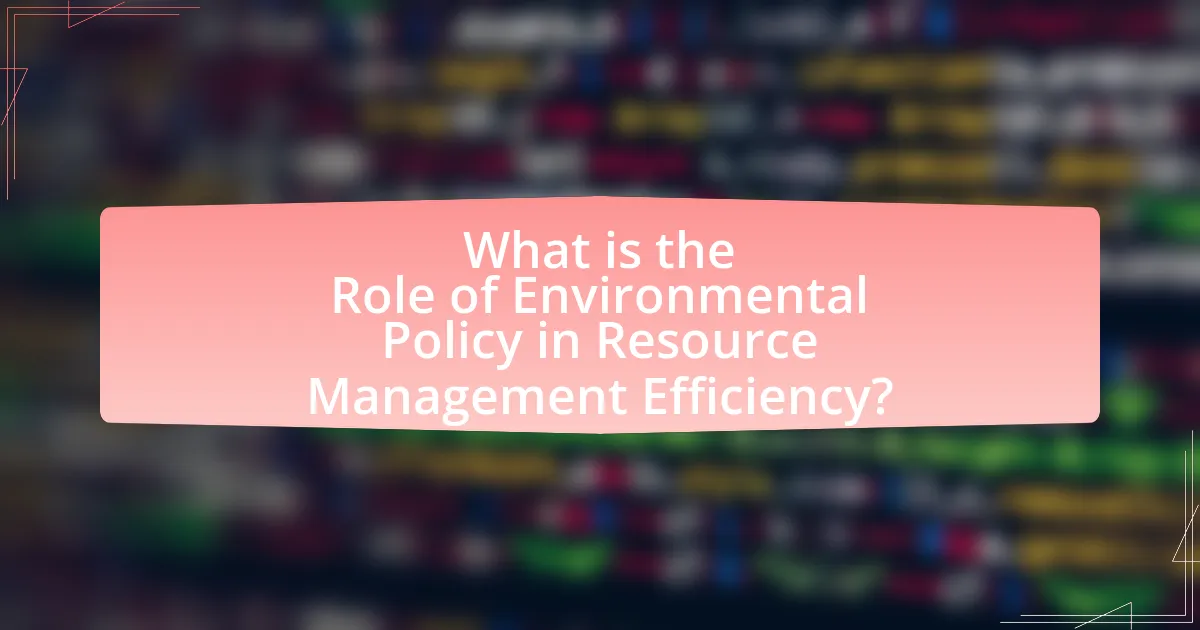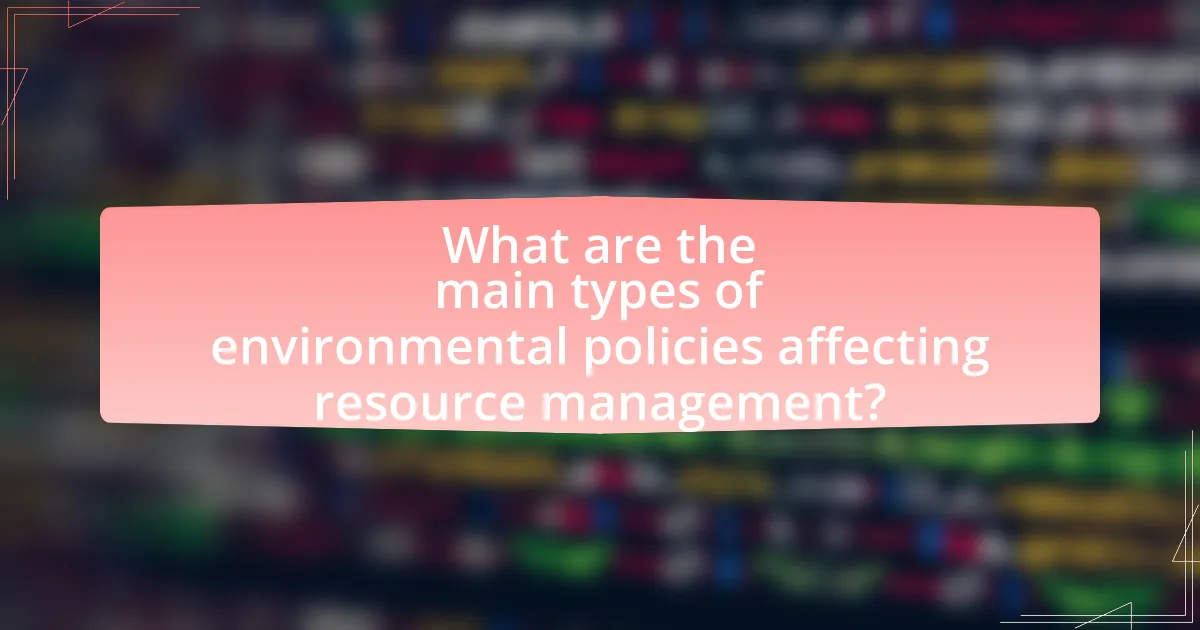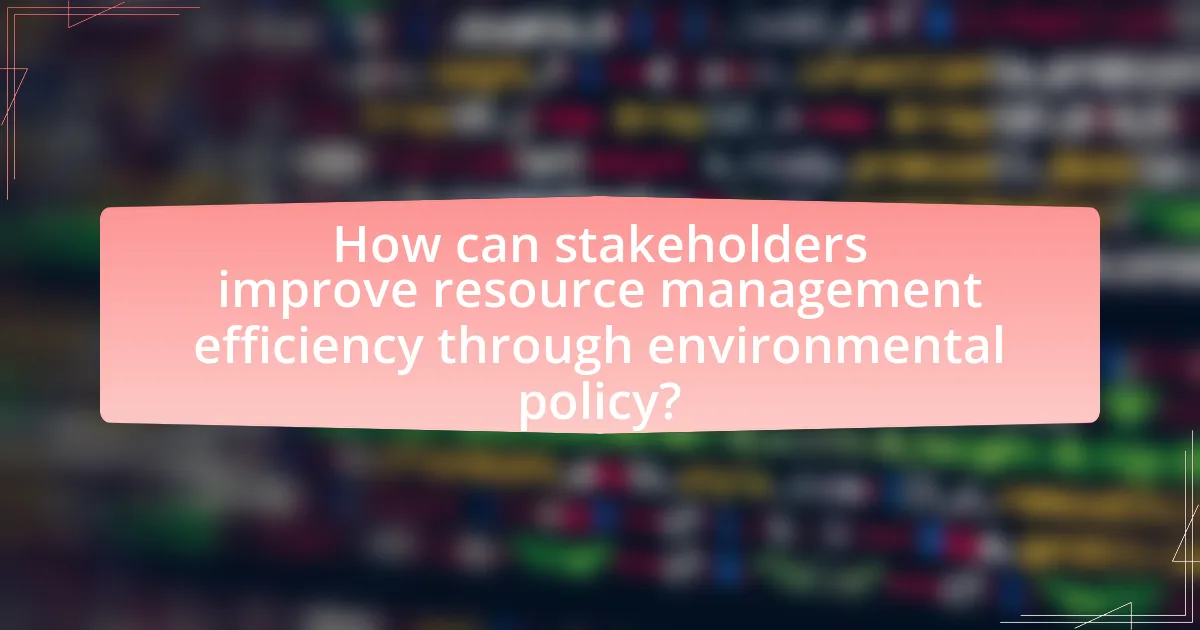Environmental policy is essential for enhancing resource management efficiency by establishing regulations and frameworks that promote sustainable practices. This article examines how environmental policies influence resource management practices, highlighting key components such as regulatory frameworks, stakeholder engagement, and monitoring mechanisms. It discusses the impact of inefficient resource management on the environment, the role of market-based instruments, and the importance of government incentives in promoting sustainable practices. Additionally, it outlines practical steps for implementing effective environmental policies to optimize resource use and minimize environmental degradation, ultimately contributing to sustainability goals.

What is the Role of Environmental Policy in Resource Management Efficiency?
Environmental policy plays a crucial role in enhancing resource management efficiency by establishing regulations and frameworks that promote sustainable practices. These policies guide the allocation and use of natural resources, ensuring that they are utilized in a manner that minimizes waste and environmental degradation. For instance, the implementation of policies such as emissions trading systems has been shown to reduce greenhouse gas emissions while maintaining economic growth, as evidenced by the European Union’s Emissions Trading System, which has successfully cut emissions by 35% since its inception in 2005. Additionally, environmental policies often incentivize the adoption of renewable energy sources, leading to more efficient resource use and reduced reliance on fossil fuels. This structured approach not only conserves resources but also fosters innovation in resource management technologies, ultimately contributing to a more sustainable economy.
How does environmental policy influence resource management practices?
Environmental policy significantly influences resource management practices by establishing regulations and guidelines that dictate how natural resources are utilized and conserved. These policies often aim to promote sustainability, reduce environmental degradation, and ensure equitable resource distribution. For instance, the implementation of the Clean Water Act in the United States has led to improved water quality management practices by requiring industries to limit pollutants, thereby influencing how water resources are managed. Additionally, policies like the European Union’s Common Agricultural Policy incentivize sustainable farming practices, which directly affect land and water resource management. Such regulations not only shape operational practices but also encourage innovation in resource efficiency, as organizations adapt to comply with environmental standards.
What are the key components of environmental policy related to resource management?
The key components of environmental policy related to resource management include regulatory frameworks, sustainable practices, stakeholder engagement, and monitoring and evaluation mechanisms. Regulatory frameworks establish legal standards and guidelines for resource use, ensuring compliance with environmental protection laws. Sustainable practices promote the efficient use of resources, minimizing waste and environmental impact, as seen in initiatives like the circular economy. Stakeholder engagement involves collaboration with communities, businesses, and governments to align interests and foster shared responsibility for resource management. Monitoring and evaluation mechanisms assess the effectiveness of policies and practices, enabling adjustments based on data and outcomes, which is crucial for continuous improvement in resource management efficiency.
How do these components interact with resource management efficiency?
Environmental policy components interact with resource management efficiency by establishing regulations and incentives that promote sustainable practices. These policies guide resource allocation, ensuring that resources are used optimally while minimizing waste and environmental impact. For instance, regulations on emissions can lead to the adoption of cleaner technologies, which enhance efficiency in resource use. Studies have shown that countries with stringent environmental policies, such as the European Union’s Green Deal, experience improved resource management outcomes, including reduced resource consumption and increased recycling rates. This demonstrates that effective environmental policies directly contribute to enhanced resource management efficiency by aligning economic activities with sustainability goals.
Why is resource management efficiency important in the context of environmental policy?
Resource management efficiency is crucial in the context of environmental policy because it directly impacts sustainability and conservation efforts. Efficient resource management minimizes waste and optimizes the use of natural resources, which is essential for maintaining ecological balance. For instance, the United Nations Environment Programme reports that improving resource efficiency can reduce greenhouse gas emissions by up to 30% by 2030, highlighting the significant role of effective management in combating climate change. Additionally, efficient resource use supports economic growth while preserving ecosystems, demonstrating that environmental policy must prioritize resource management to achieve long-term environmental and economic goals.
What are the environmental impacts of inefficient resource management?
Inefficient resource management leads to significant environmental impacts, including habitat destruction, pollution, and depletion of natural resources. For instance, over-extraction of water resources can result in the drying up of rivers and lakes, adversely affecting aquatic ecosystems. Additionally, poor waste management practices contribute to soil and water contamination, which can harm wildlife and human health. According to the United Nations Environment Programme, inefficient resource use accounts for approximately 90% of biodiversity loss and 50% of greenhouse gas emissions globally. This data underscores the critical need for effective environmental policies to enhance resource management efficiency and mitigate these adverse impacts.
How can efficient resource management contribute to sustainability goals?
Efficient resource management directly contributes to sustainability goals by optimizing the use of natural resources, reducing waste, and minimizing environmental impact. By implementing practices such as recycling, energy conservation, and sustainable sourcing, organizations can decrease their carbon footprint and preserve ecosystems. For instance, a study by the World Resources Institute found that improving resource efficiency could reduce global greenhouse gas emissions by up to 70% by 2050. This demonstrates that effective resource management not only supports economic growth but also aligns with environmental sustainability objectives.

What are the main types of environmental policies affecting resource management?
The main types of environmental policies affecting resource management include regulatory policies, market-based instruments, and voluntary agreements. Regulatory policies, such as the Clean Air Act and the Clean Water Act in the United States, set legal limits on pollution and resource use, directly influencing how resources are managed. Market-based instruments, like carbon pricing and tradable permits, create economic incentives for reducing environmental impact, encouraging more efficient resource use. Voluntary agreements involve partnerships between governments and industries to promote sustainable practices without mandatory regulations, exemplified by initiatives like the Energy Star program. These policies collectively shape resource management by establishing frameworks that guide behavior and decision-making in environmental conservation.
How do regulatory policies shape resource management efficiency?
Regulatory policies shape resource management efficiency by establishing frameworks that promote sustainable practices and optimize resource use. These policies often include standards and guidelines that compel organizations to minimize waste, reduce emissions, and enhance conservation efforts. For example, the implementation of the Clean Air Act in the United States has led to significant reductions in air pollutants, which in turn has improved public health and resource allocation in energy sectors. Studies indicate that regions with stringent environmental regulations often experience higher levels of innovation in resource management technologies, demonstrating a direct correlation between regulatory frameworks and efficiency outcomes.
What are examples of regulatory policies in resource management?
Examples of regulatory policies in resource management include water quality standards, emissions regulations, and land use planning. Water quality standards, established under the Clean Water Act in the United States, set limits on pollutants to protect aquatic ecosystems and human health. Emissions regulations, such as those enforced by the Environmental Protection Agency, limit the amount of harmful substances that can be released into the air from industrial sources, thereby reducing air pollution and its associated health risks. Land use planning policies, often guided by zoning laws, regulate how land can be developed and used, ensuring sustainable practices that balance economic growth with environmental protection. These policies are essential for maintaining resource sustainability and promoting environmental health.
How effective are these policies in promoting efficiency?
Environmental policies are highly effective in promoting efficiency in resource management. These policies often lead to reduced waste, optimized resource use, and increased sustainability. For instance, regulations that mandate emissions reductions have been shown to drive innovation in cleaner technologies, resulting in more efficient production processes. A study by the National Bureau of Economic Research found that firms subject to stricter environmental regulations improved their energy efficiency by an average of 15%. This demonstrates that well-designed environmental policies can significantly enhance efficiency while also addressing ecological concerns.
What role do market-based instruments play in resource management?
Market-based instruments play a crucial role in resource management by providing economic incentives that encourage sustainable practices and efficient resource use. These instruments, such as carbon pricing, tradable permits, and subsidies for renewable energy, create a financial framework that aligns economic activities with environmental goals. For instance, the implementation of cap-and-trade systems has been shown to reduce greenhouse gas emissions effectively while allowing businesses flexibility in how they meet regulatory requirements. According to a study by the World Bank, countries that adopted market-based mechanisms have seen significant reductions in pollution levels, demonstrating their effectiveness in promoting resource efficiency.
How do taxes and subsidies influence resource management practices?
Taxes and subsidies significantly influence resource management practices by altering economic incentives for resource use and conservation. Taxes on resource extraction or pollution create a financial disincentive, encouraging businesses and individuals to adopt more sustainable practices to minimize costs. For example, carbon taxes have been shown to reduce greenhouse gas emissions by incentivizing cleaner technologies. Conversely, subsidies can promote resource conservation by providing financial support for sustainable practices, such as renewable energy projects or water conservation initiatives. Research indicates that countries implementing subsidies for renewable energy have seen increased investment in sustainable technologies, leading to more efficient resource management. Thus, the strategic use of taxes and subsidies can effectively guide resource management towards sustainability and efficiency.
What are the advantages and disadvantages of market-based instruments?
Market-based instruments offer both advantages and disadvantages in the context of environmental policy and resource management efficiency. The primary advantage is that they create economic incentives for reducing pollution and promoting sustainable practices, which can lead to cost-effective environmental improvements. For instance, cap-and-trade systems allow companies to buy and sell emission allowances, encouraging those who can reduce emissions at lower costs to do so, thereby achieving overall reductions more efficiently.
Conversely, a significant disadvantage is that market-based instruments can lead to unequal outcomes, where wealthier entities may afford to pay for pollution rights, potentially exacerbating environmental injustices. Additionally, these instruments may not adequately address all environmental issues, as they often focus on quantifiable pollutants while neglecting broader ecological impacts. For example, the European Union Emissions Trading System has faced criticism for not sufficiently addressing biodiversity loss.

How can stakeholders improve resource management efficiency through environmental policy?
Stakeholders can improve resource management efficiency through environmental policy by implementing regulations that promote sustainable practices and resource conservation. For instance, policies that incentivize renewable energy use can reduce dependency on fossil fuels, leading to more efficient resource utilization. According to the International Energy Agency, countries that adopted renewable energy policies saw a 20% increase in energy efficiency over a decade. Additionally, stakeholders can engage in collaborative initiatives that align economic goals with environmental sustainability, such as the adoption of circular economy principles, which have been shown to reduce waste and enhance resource recovery. This approach not only optimizes resource use but also fosters innovation and economic growth, as evidenced by a report from the Ellen MacArthur Foundation, which estimates that transitioning to a circular economy could generate $4.5 trillion in economic benefits by 2030.
What strategies can businesses adopt to align with environmental policies?
Businesses can adopt strategies such as implementing sustainable practices, enhancing energy efficiency, and engaging in corporate social responsibility to align with environmental policies. By integrating sustainable practices, businesses can reduce waste and minimize their carbon footprint, which is essential for compliance with regulations like the Paris Agreement. Enhancing energy efficiency through technologies such as LED lighting and energy management systems can lead to significant cost savings and lower greenhouse gas emissions, supporting policies aimed at reducing energy consumption. Additionally, engaging in corporate social responsibility initiatives, such as community clean-up programs or sustainable sourcing, demonstrates a commitment to environmental stewardship, which can improve public perception and align with governmental and societal expectations for environmental responsibility.
How can companies measure their resource management efficiency?
Companies can measure their resource management efficiency by utilizing key performance indicators (KPIs) such as resource utilization rates, waste reduction metrics, and cost savings from resource optimization. These KPIs provide quantifiable data that reflects how effectively a company is using its resources. For instance, a study by the World Resources Institute indicates that companies implementing resource efficiency measures can reduce operational costs by up to 30%, demonstrating the financial benefits of effective resource management. Additionally, benchmarking against industry standards allows companies to assess their performance relative to peers, further validating their efficiency metrics.
What best practices can enhance compliance with environmental policies?
Implementing comprehensive training programs for employees enhances compliance with environmental policies. These programs educate staff on regulations, best practices, and the importance of sustainability, leading to increased awareness and adherence. For instance, a study by the Environmental Protection Agency found that organizations with regular training sessions reported a 30% improvement in compliance rates. Additionally, establishing clear communication channels for reporting environmental concerns fosters a culture of accountability and proactive engagement, further supporting adherence to policies.
What role do governments play in facilitating efficient resource management?
Governments play a crucial role in facilitating efficient resource management by establishing regulations, providing incentives, and promoting sustainable practices. Through legislation, governments can enforce environmental standards that limit resource depletion and pollution, ensuring that natural resources are used responsibly. For example, the implementation of the Clean Air Act in the United States has led to significant reductions in air pollutants, demonstrating how regulatory frameworks can enhance resource management. Additionally, governments can offer financial incentives, such as tax breaks or grants, to encourage businesses and individuals to adopt sustainable technologies and practices, further promoting efficient resource use. By investing in research and development for renewable energy sources, governments can also drive innovation that leads to more sustainable resource management solutions.
How can government incentives promote better resource management practices?
Government incentives can promote better resource management practices by providing financial support and regulatory advantages that encourage sustainable behaviors among businesses and individuals. For instance, tax credits for renewable energy installations incentivize companies to adopt cleaner technologies, leading to reduced resource consumption and lower environmental impact. A study by the International Renewable Energy Agency found that countries implementing such incentives saw a 20% increase in renewable energy capacity within five years, demonstrating the effectiveness of financial motivation in driving resource-efficient practices.
What collaborative efforts can enhance policy effectiveness in resource management?
Collaborative efforts that can enhance policy effectiveness in resource management include stakeholder engagement, inter-agency cooperation, and public-private partnerships. Stakeholder engagement ensures that diverse perspectives are considered, leading to more comprehensive policies; for example, involving local communities in decision-making can improve compliance and sustainability outcomes. Inter-agency cooperation facilitates the sharing of data and resources, which can streamline efforts and reduce redundancy; the U.S. Environmental Protection Agency and the Department of Agriculture often collaborate on water quality initiatives to maximize impact. Public-private partnerships leverage the strengths of both sectors, as seen in initiatives like the Global Water Partnership, which combines governmental support with private sector innovation to address water scarcity. These collaborative approaches are supported by research indicating that inclusive and cooperative frameworks lead to more effective and adaptive resource management policies.
What are practical steps for implementing effective environmental policies in resource management?
Practical steps for implementing effective environmental policies in resource management include establishing clear regulatory frameworks, engaging stakeholders, and utilizing data-driven decision-making. Clear regulatory frameworks provide guidelines that ensure compliance and accountability, which is essential for effective resource management. Engaging stakeholders, including local communities, businesses, and environmental organizations, fosters collaboration and enhances the legitimacy of policies. Data-driven decision-making, supported by environmental assessments and monitoring, allows for informed choices that optimize resource use and minimize environmental impact. These steps are validated by successful case studies, such as the European Union’s Water Framework Directive, which has improved water quality across member states through structured policy implementation and stakeholder involvement.


